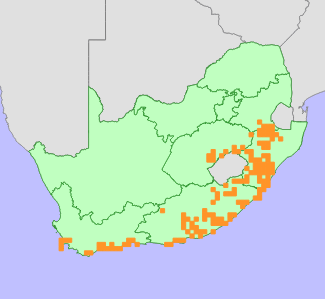| Scientific Name | Aloe maculata All. | Higher Classification | Monocotyledons | Family | ASPHODELACEAE | Synonyms | Aloe disticha Mill. (later homonym), not of L. (1753), Aloe latifolia (Haw.) Haw., Aloe leptophylla N.E.Br. ex Baker, Aloe leptophylla N.E.Br. ex Baker var. stenophylla Baker, Aloe macracantha Baker, Aloe maculosa Lam., Aloe perfoliata L. var. lambda L., Aloe perfoliata L. var. saponaria Aiton, Aloe perfoliata L. var. theta L., Aloe saponaria (Aiton) Haw., Aloe saponaria (Aiton) Haw. var. brachyphylla Baker, Aloe saponaria (Aiton) Haw. var. ficksburgensis Reynolds, Aloe saponaria (Aiton) Haw. var. latifolia Haw., Aloe umbellata DC. | Common Names | Amahlala (z), Bontaalwyn (a), Common Soap Aloe (e), Icena (z), Ingcelwane (x), Lekhala (ss), Lekhala La Thaba (ss) |
National Status | Status and Criteria | Least Concern | Assessment Date | 2018/10/03 | Assessor(s) | L. von Staden | Justification | Aloe maculata is a widespread and common species and is not in danger of extinction. |
Distribution | Endemism | Not endemic to South Africa | Provincial distribution | Eastern Cape, Free State, KwaZulu-Natal, Mpumalanga, Western Cape | Range | This species is extremely widespread and common in South Africa, where it ranges from the Cape Peninsula along the Western Cape south coast to the Eastern Cape, where it also occurs further inland in the northern parts of the Eastern Cape to the Drakensberg foothills. It is also found on the highlands of Lesotho and the Free State, but does not occur on the highest peaks of the Drakensberg Escarpment. In KwaZulu-Natal the range extends along the Drakensberg foothills and through the Midlands northwards to southern Mpumalanga. |
Habitat and Ecology | Major system | Terrestrial | Major habitats | Basotho Montane Shrubland, KwaZulu-Natal Hinterland Thornveld, Pondoland-Ugu Sandstone Coastal Sourveld, Moist Coast Hinterland Grassland, Eastern Ruens Shale Renosterveld, Northern Zululand Mistbelt Grassland, Eastern Free State Sandy Grassland, Eastern Free State Clay Grassland, Paulpietersburg Moist Grassland, Wakkerstroom Montane Grassland, Lesotho Highland Basalt Grassland, South Eastern Coastal Thornveld, Drakensberg Foothill Moist Grassland, Albany Mesic Thicket, Northern Drakensberg Highland Grassland, Canca Limestone Fynbos, Garden Route Granite Fynbos, KwaZulu-Natal Coastal Belt Thornveld, KwaZulu-Natal Coastal Belt Grassland, Nanaga Savanna Thicket, Hartenbos Dune Thicket, Grahamstown Grassland Thicket, Escarpment Mesic Thicket, Southern Drakensberg Highland Grassland, KwaZulu-Natal Highland Thornveld, Zululand Lowveld, Amathole Montane Grassland, Southern KwaZulu-Natal Moist Grassland, Midlands Mistbelt Grassland, Mooi River Highland Grassland, Thukela Thornveld, Northern Zululand Sourveld, Eastern Valley Bushveld, Northern KwaZulu-Natal Moist Grassland, East Griqualand Grassland, Mthatha Moist Grassland, Bhisho Thornveld, Tsomo Grassland, Dry Coast Hinterland Grassland, KwaZulu-Natal Sandstone Sourveld, Hamburg Dune Thicket, Thukela Valley Bushveld, Albany Valley Thicket, Subtropical Dune Thicket, Subtropical Alluvial Vegetation, Buffels Valley Thicket, Sundays Mesic Thicket, Doubledrift Karroid Thicket, Fish Arid Thicket, Peninsula Granite Fynbos, Fish Valley Thicket, Goukamma Dune Thicket, Gamka Valley Thicket, Cape Lowland Alluvial Vegetation, Cape Flats Dune Strandveld, Mabela Sandy Grassland, KaNgwane Montane Grassland, Tarkastad Montane Shrubland, Bedford Dry Grassland, Amersfoort Highveld Clay Grassland, Karoo Escarpment Grassland, uKhahlamba Basalt Grassland, Agulhas Sand Fynbos, Groot Brak Dune Strandveld, Transkei Coastal Belt, Humansdorp Shale Renosterveld, Mossel Bay Shale Renosterveld, Income Sandy Grassland, Agulhas Limestone Fynbos, Garden Route Shale Fynbos, Albertinia Sand Fynbos, Southern Cape Dune Fynbos, Knysna Sand Fynbos, Low Escarpment Moist Grassland | Description | It occurs in highly variable habitats. It is found mostly in grassland, from sea level to high altitude alpine flora in the Drakensberg, but also often in rocky outcrops and thicket vegetation. |
Population | Population trend | Stable |
Assessment History |
Taxon assessed |
Status and Criteria |
Citation/Red List version | | Aloe maculata All. | Least Concern | Raimondo et al. (2009) | |
Bibliography | Glen, H.F. and Hardy, D.S. 2000. Aloaceae (First part): Aloe. In: G. Germishuizen (ed). Flora of Southern Africa 5 Part 1, Fascicle 1:1-159. National Botanical Institute, Pretoria.
Goldblatt, P. and Manning, J.C. 2000. Cape Plants: A conspectus of the Cape Flora of South Africa. Strelitzia 9. National Botanical Institute, Cape Town.
Manning, J.C. and Goldblatt, P. 2012. Plants of the Greater Cape Floristic Region 1: The Core Cape Flora. Strelitzia 29. South African National Biodiversity Institute, Pretoria.
Pooley, E. 2003. Mountain flowers: a field guide to the flora of the Drakensberg and Lesotho. Natal Flora Publications Trust, Durban.
Raimondo, D., von Staden, L., Foden, W., Victor, J.E., Helme, N.A., Turner, R.C., Kamundi, D.A. and Manyama, P.A. 2009. Red List of South African Plants. Strelitzia 25. South African National Biodiversity Institute, Pretoria.
Reynolds, G.W. 1969. The Aloes of South Africa. A.A. Balkema, Cape Town.
Scott-Shaw, C.R. 1999. Rare and threatened plants of KwaZulu-Natal and neighbouring regions. KwaZulu-Natal Nature Conservation Service, Pietermaritzburg.
Van Wyk, B.-E. and Smith, G. 1996. Guide to the aloes of South Africa. Briza Publications, Pretoria.
Van Wyk, B.-E. and Smith, G. 2003. Guide to aloes of South Africa. (2nd ed.). Briza Publications, Pretoria.
Vlok, J. and Schutte-Vlok, A.L. 2010. Plants of the Klein Karoo. Umdaus Press, Hatfield.
|
Citation | | von Staden, L. 2018. Aloe maculata All. National Assessment: Red List of South African Plants version 2024.1. Accessed on 2025/12/23 |
 Comment on this assessment Comment on this assessment
|
 © D. Turner  © D. Turner  © C. Merry  © J.H. Vlok/A.L. Schutte-Vlok
Search for images of Aloe maculata on iNaturalist
|
 Comment on this assessment
Comment on this assessment

